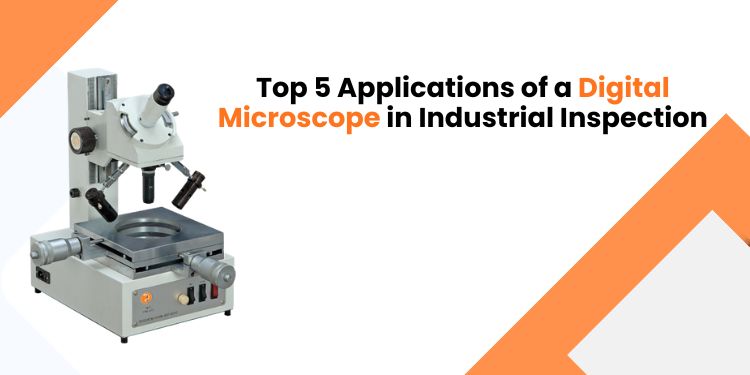
The versatility of digital microscopes has made them a cornerstone in sectors such as electronics, automotive, aerospace, and medical device manufacturing. They provide high-resolution imaging, facilitate accurate measurements, and allow for efficient documentation of inspection processes. By adopting digital microscope technology, manufacturers can reduce errors, enhance quality control, and improve workflow efficiency. Understanding the top applications of a digital microscope helps organizations maximize its benefits and select the right equipment for their operations.
Key Applications of Digital Microscopes in Industrial Inspection
Digital microscopes are employed across industries for various inspection tasks. Their applications range from surface analysis to precise dimensional measurement. Below, we explore the top five industrial uses that demonstrate the value of this technology.
Detect Surface Defects and Material Flaws
One of the primary applications of a digital microscope is detecting surface defects such as scratches, cracks, or corrosion. High-resolution imaging allows inspectors to identify even the smallest imperfections that could affect product performance. This capability is essential in industries like aerospace and automotive, where material integrity is critical. By accurately detecting flaws early, manufacturers can prevent defective products from reaching the market, reduce rework, and maintain high standards of quality control.
Conduct Precise Dimensional Measurements
Digital microscopes offer advanced measurement tools that allow for accurate dimensional inspection of components. Engineers can measure lengths, widths, angles, and diameters directly on the digital image, ensuring components meet design specifications. This function is particularly useful in precision engineering, electronics manufacturing, and toolmaking. Using these measurement capabilities reduces reliance on manual instruments, increases accuracy, and accelerates the inspection process, contributing to higher production efficiency.
Analyze Microelectronics and PCB Components
In the electronics industry, inspecting printed circuit boards and microelectronics is a critical task. Digital microscopes provide clear visualization of solder joints, component alignment, and trace connections. They enable quality control teams to identify defects such as solder bridges, missing components, or misaligned pins. By using digital microscopes for microelectronics inspection, manufacturers can prevent functional failures, improve product reliability, and maintain compliance with industry standards.
Document Inspection Results Efficiently
Digital microscopes integrate with computer systems, allowing users to capture and store images or videos of inspected components. This documentation is valuable for quality assurance records, compliance audits, and traceability. Industrial teams can easily share inspection data with engineers, clients, or suppliers, ensuring transparent and verifiable quality control processes. The ability to save and analyze inspection records over time also supports continuous improvement initiatives and informed decision-making.
Support Toolmaking and Precision Engineering
Toolmakers and precision engineers rely on high-accuracy visual inspection to maintain component tolerances. Digital microscopes assist in examining tool surfaces, cutting edges, and intricate mechanical parts. By providing detailed visualization and measurement capabilities, these microscopes help manufacturers optimize tool performance, reduce wear, and extend equipment lifespan. Collaborating with a skilled toolmaker microscope manufacturer ensures access to equipment designed specifically for these demanding industrial applications.
Factors to Consider When Choosing a Digital Microscope
Selecting the right digital microscope involves evaluating several critical factors. Resolution, magnification range, lighting options, and connectivity are primary considerations. Additionally, manufacturers should assess software usability, compatibility with existing workflows, and durability under industrial conditions.
- Resolution and Image Quality: Ensure the microscope provides high-resolution imaging to detect even the smallest defects.
- Magnification Range: Choose a microscope that offers suitable magnification levels for the components you inspect.
- Lighting Options: Consider built-in LED lighting, adjustable intensity, and options for reflected or transmitted light.
- Software Usability: Look for intuitive software that allows easy measurement, analysis, and reporting.
- Connectivity and Integration: Check compatibility with computers, CAD software, and quality management systems for seamless workflow integration.
- Durability and Industrial Suitability: Ensure the microscope is robust enough for industrial environments and continuous use.
- Cost vs. Long-Term Value: Evaluate pricing in terms of performance, reliability, and potential ROI rather than just upfront cost.
Conclusion
Adopting digital microscopes in industrial inspection offers clear advantages for manufacturing businesses. From identifying material flaws and performing accurate measurements to documenting inspection processes and supporting precision toolmaking, these instruments enhance product quality and operational efficiency. By selecting a reliable toolmakers microscope manufacturer, organizations can access high-performance solutions that meet their specific inspection requirements, paving the way for consistent quality, reduced errors, and improved productivity.


